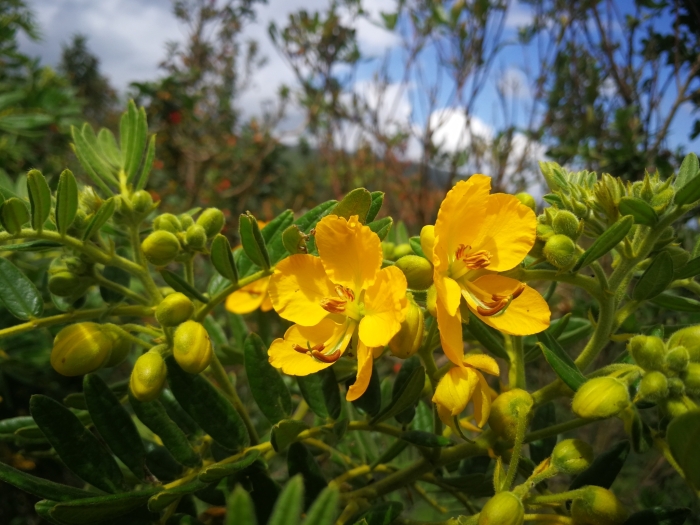Glandular Senna
(Senna multiglandulosa)
Glandular Senna (Senna multiglandulosa)
/
/

sandy-espinozaf
CC BY 4.0
Image By:
sandy-espinozaf
Recorded By:
Copyright:
CC BY 4.0
Copyright Notice:
Photo by: sandy-espinozaf | License Type: CC BY 4.0 | License URL: http://creativecommons.org/licenses/by/4.0/ | Rights Holder: sandy-espinozaf | Publisher: iNaturalist | Date Created: 2019-12-29T11:45:53-08:00 |
























Estimated Native Range
Summary
Senna multiglandulosa, commonly known as Glandular Senna, is an evergreen shrub or small tree native to a variety of habitats including open woodlands, forest edges, and scrub areas in Mexico, Central and South America. It can grow up to six meters in height and often takes on a tree-like form with a hairy or woolly texture. The inflorescence is a raceme composed of several flowers, each showcasing five golden yellow petals that are 1 to 2 centimeters long. Glandular Senna is notable for its extended blooming period, producing vibrant yellow and orange flowers primarily in the winter, spring, and summer months, which are highly attractive to pollinators such as bees and butterflies.
The plant is valued for its ornamental flowers and its ability to thrive with minimal care, making it suitable for xeriscaping and as an accent plant in tropical and subtropical gardens. It is also used for erosion control due to its fast growth and adaptability to various soil conditions. Glandular Senna prefers full sun exposure and can tolerate low to medium water conditions, thriving in soils with slow to medium drainage. While it is generally disease-resistant, it can occasionally suffer from pests such as aphids and caterpillars. Gardeners should be aware of its potential to become invasive in some regions, and it should be managed accordingly to prevent unwanted spread.CC BY-SA 4.0
The plant is valued for its ornamental flowers and its ability to thrive with minimal care, making it suitable for xeriscaping and as an accent plant in tropical and subtropical gardens. It is also used for erosion control due to its fast growth and adaptability to various soil conditions. Glandular Senna prefers full sun exposure and can tolerate low to medium water conditions, thriving in soils with slow to medium drainage. While it is generally disease-resistant, it can occasionally suffer from pests such as aphids and caterpillars. Gardeners should be aware of its potential to become invasive in some regions, and it should be managed accordingly to prevent unwanted spread.CC BY-SA 4.0
Plant Description
- Plant Type: Shrub, Tree
- Height: 7-12 feet
- Width: 6-12 feet
- Growth Rate: Moderate
- Flower Color: Yellow
- Flowering Season: Spring, Summer
- Leaf Retention: Evergreen
Growth Requirements
- Sun: Full Sun
- Water: Low, Medium
- Drainage: Medium
Common Uses
Bee Garden, Bird Garden, Butterfly Garden, Low Maintenance, Showy Flowers
Natural Habitat
native to a variety of habitats including open woodlands, forest edges, and scrub areas in Mexico, Central and South America
Other Names
Common Names: Downy Senna, Buttercup Bush
Scientific Names: , Senna multiglandulosa, Cassia tomentosa, Cassia multiglandulosa, Cassia wightiana, Adipera tomentosa, Cassia albida, Cassia cana, Cassia lutescens, Cassia pubescens
GBIF Accepted Name: Senna multiglandulosa (Jacq.) H.S.Irwin & Barneby